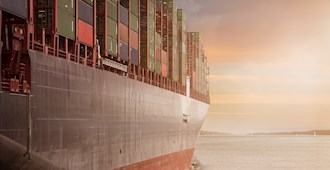Sustainability in Logistics & Freight Forwarding
Date: 16/02/2024
In the dynamic landscape of global commerce, the call for sustainable practices has surged. Read on as we delve into the pivotal role of sustainable logistics.
In the dynamic landscape of global commerce, the call for sustainable practices has surged. The imperative for sustainability in logistics and freight forwarding intensifies amid climate change concerns and growing pressure to reduce carbon footprints.
The transportation and storage of goods, integral to these industries, now stand under scrutiny for their environmental implications. In this context, acting as intermediaries facilitating worldwide trade day in and day out, freight forwarders play a pivotal role in promoting sustainability within the supply chain.
Read on as we delve into the pivotal role of sustainable logistics. We’ll walk through strategies that encompass every facet of operations in response to the urgent need for eco-friendly supply chain models, reshaping the narrative of a sustainable tomorrow.
What is Sustainable Logistics?
Sustainable logistics management involves the practice of boosting the eco-friendliness of freight and transportation. It represents a deliberate effort to reduce the environmental impact associated with these essential processes. But how can sustainability be achieved within the realm of logistics? Here, we identify critical strategic initiatives.
Optimised Travel Routes: Navigating Efficiency
In the quest for sustainability, choose routes wisely. Optimise travel routes to cut unnecessary journeys and waiting times, scaling down fuel consumption and emissions. It's not just about reaching the destination; it's about how you get there.
Greener Transport Options: Driving Change
Revolutionise your transport fleet by contemplating eco-friendly alternatives. Integrate innovations such as electric-powered vehicles and explore various sustainable transportation options. Much like the optimisation of logistics processes, where combining road freight, train freight, and inland water transport fine-tune efficacy while minimising environmental impact, implementing environmentally conscious choices for your transport fleet is a vital step toward a greener future.
Green Packaging
1. Eco-Friendly Materials
Logistics companies are increasingly incorporating sustainable packaging materials, such as biodegradable or recycled materials, to diminish waste and decrease the environmental impact of packaging. This commitment to eco-friendly materials not only addresses environmental concerns but also resonates with consumers and clients who prioritise sustainability. As a result, logistics and freight forwarding companies can improve their reputation, attract environmentally conscious partners, and contribute to the broader movement toward greener supply chain practices.
2. Packaging Optimisation
Optimising packaging design and dimensions helps maximise the use of space in transport vehicles, leading to fewer shipments, reduced packaging material consumption, and lower transportation-related emissions. This strategic approach to packaging not only streamlines operations but also significantly contributes to the sustainability goals of logistics and freight forwarding.
Supply Chain Transparency and Collaboration
1. Traceability Systems
Implementing traceability systems allows for greater visibility into the supply chain, enabling companies to monitor and manage the environmental and social impacts of their logistics activities. This heightened transparency not only facilitates compliance with regulatory standards but also fosters accountability throughout the supply chain.
The integration of traceability systems empowers companies to pinpoint areas where improvements can be made, participating in the continuous enhancement of sustainability practices. Moreover, by utilising traceability data, businesses can communicate their commitment to transparency and responsible sourcing, establishing trust with consumers and stakeholders.
2. Collaboration with Suppliers
Establishing partnerships with suppliers committed to sustainable practices ensures that the entire supply chain adheres to environmentally friendly standards. Collaborative efforts can lead to shared initiatives for reducing waste and increasing proficiency. Beyond lowering environmental impact, supplier collaboration refines overall supply chain resilience. By working closely with suppliers, companies can jointly develop innovative solutions, share best practices, and collectively address challenges related to sustainability. This collaborative approach not only strengthens the eco-friendly footprint of logistics but also establishes a network of like-minded partners dedicated to sustainable and socially responsible business practices.
Energy Efficiency in Warehousing
1. Renewable Energy Sources
To diminish their dependence on non-renewable energy and mitigate their carbon footprint, warehouses and distribution centres are increasingly incorporating renewable energy sources like solar and wind power. This not only upholds principles of environmental stewardship but also promotes the overarching objectives of energy sustainability.
The utilisation of renewable sources marks a progressive step toward the widespread adoption of clean energy practices within the logistics and warehousing sector. Beyond environmental benefits, the incorporation of renewable energy often translates into enduring cost savings and heightened resilience against the volatility of energy prices. This dual advantage underscores the economic and environmental wisdom of transitioning to sustainable energy solutions.
2. Energy-Efficient Technologies
Adopting energy-efficient technologies, such as LED lighting and automated systems, helps lessen energy consumption in warehouses, contributing to sustainability goals. The implementation of LED lighting not only reduces electricity usage but also extends the lifespan of lighting systems, decreasing the frequency of replacements and associated waste. Automated systems, including smart sensors and robotics, enforce energy usage by responding to real-time demand, thereby enhancing operational performance.
Waste Reduction and Recycling
1. Waste Management Programs
Employing effective waste management programs makes sure that proper disposal of waste is generated during logistics operations. Engaging in recycling initiatives holds paramount significance in mitigating the environmental repercussions of packaging materials and other waste generated through logistics activities. This dedication extends beyond mere compliance with regulatory requirements, reflecting a steadfast commitment to environmentally responsible business practices.
2. Circular Economy Practices
Moving towards a circular economy involves designing logistics processes that prioritise the reuse and recycling of materials, minimising the creation of waste, and promoting sustainable resource use. By embracing circularity, logistics companies position themselves as environmental stewards committed to lowering their ecological footprint.
In summary, the progression toward green logistics and freight forwarding represents a multifaceted endeavour. From the optimisation of travel routes to the integration of digital solutions and the development of partnerships with sustainable suppliers, each strategic measure contributes to fostering a more environmentally conscious and responsible industry. The future landscape of logistics extends beyond mere destination fulfilment; it revolves around the methods employed, guaranteeing the establishment of a sustainable and flourishing world for future generations. For ongoing updates on these dynamic industry changes, please visit our website at WLP.




